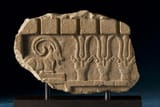Search Results
7/10/2025, 5:41:43 PM
>>40690126
https://en.wikipedia.org/wiki/%CA%BFA%E1%B9%AFtar
>Aṯtar is a deity whose role, name, and even gender varied across ancient Semitic religion. In both genders, ʿAṯtar is identified with the planet Venus, the morning and evening star. ʿAṯtar is a prominent character in the Baal Cycle.
>ʿAštar
A possible Phoenician variant of ʿAštar might be attested as a theophoric element 𐤏𐤔𐤕𐤓 (ʿAštar) in a personal name from Byblos, 𐤏𐤔𐤕𐤓𐤇𐤍 (ʿŠTR-ḤN).
>The name appears in various Semitic languages as:
>the feminine form Ištar (𒀭𒀹𒁯) in Akkadian;
>the masculine form ʿAṯtar (عثتر, Arabic pronunciation: [ʕaθ.tar]) in Arabic;
and the masculine form ʿÄstär (ዐስተር) in Ethiosemitic.
>and the masculine form ʿÄstär (ዐስተር) in Ethiosemitic.
>Ästär
>ʿAštar-Kamōš
ʿAštar was attested among the Canaanite people of the Moabites during the 9th century BC, when he was identified with the patron god of Moab, 𐤊𐤌𐤔 (Kamōš), in the form of 𐤏𐤔𐤕𐤓𐤊𐤌𐤔 (ʿAštar-Kamōš).
https://en.wikipedia.org/wiki/%CA%BFA%E1%B9%AFtar
>Aṯtar is a deity whose role, name, and even gender varied across ancient Semitic religion. In both genders, ʿAṯtar is identified with the planet Venus, the morning and evening star. ʿAṯtar is a prominent character in the Baal Cycle.
>ʿAštar
A possible Phoenician variant of ʿAštar might be attested as a theophoric element 𐤏𐤔𐤕𐤓 (ʿAštar) in a personal name from Byblos, 𐤏𐤔𐤕𐤓𐤇𐤍 (ʿŠTR-ḤN).
>The name appears in various Semitic languages as:
>the feminine form Ištar (𒀭𒀹𒁯) in Akkadian;
>the masculine form ʿAṯtar (عثتر, Arabic pronunciation: [ʕaθ.tar]) in Arabic;
and the masculine form ʿÄstär (ዐስተር) in Ethiosemitic.
>and the masculine form ʿÄstär (ዐስተር) in Ethiosemitic.
>Ästär
>ʿAštar-Kamōš
ʿAštar was attested among the Canaanite people of the Moabites during the 9th century BC, when he was identified with the patron god of Moab, 𐤊𐤌𐤔 (Kamōš), in the form of 𐤏𐤔𐤕𐤓𐤊𐤌𐤔 (ʿAštar-Kamōš).
Page 1
